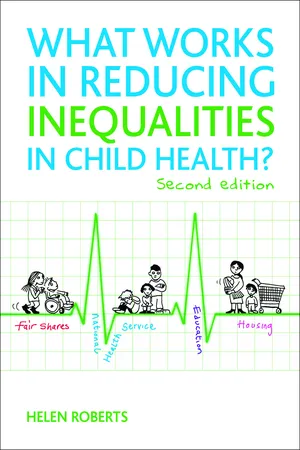
- 208 pages
- English
- PDF
- Available on iOS & Android
About this book
The UK has a deservedly strong reputation for work on understanding social inequalities in health, but there is some way to go in using research and other types of knowledge to reduce inequalities in child health. This revised and updated edition of an important report looks at macro public policy interventions, community interventions, and individual level interventions in a variety of settings, including infancy, early years, childhood, adolescence, and particular needs including looked after children. It considers 'what works' - or might work - in practice. There are new case studies, updated research references, and new reference to cost effectiveness - all relevant for doing the right thing in a climate of austerity. Drawing on evidence from the UK and beyond, the book presents these in an accessible form, not just for those who make decisions now, but also for the students of today who are the decision makers of tomorrow. The book is supported by a companion website, containing additional materials for both students and lecturers, which is available from the link above.
Frequently asked questions
- Essential is ideal for learners and professionals who enjoy exploring a wide range of subjects. Access the Essential Library with 800,000+ trusted titles and best-sellers across business, personal growth, and the humanities. Includes unlimited reading time and Standard Read Aloud voice.
- Complete: Perfect for advanced learners and researchers needing full, unrestricted access. Unlock 1.4M+ books across hundreds of subjects, including academic and specialized titles. The Complete Plan also includes advanced features like Premium Read Aloud and Research Assistant.
Please note we cannot support devices running on iOS 13 and Android 7 or earlier. Learn more about using the app.
Information
Table of contents
- What Works in Reducing Inequalities in Child Health?
- Contents
- Tables and figures
- Acknowledgements
- Foreword
- Preface
- 1. Introduction
- 2. What kinds of studies help us understand what works?
- 3. What works in early life? Infancy and the pre-school period
- 4. What works in childhood and adolescence?
- 5. What works in keeping children safe?
- 6. What works for vulnerable groups?
- 7. Tackling the causes of the causes
- References
- Web and other resources
- Index